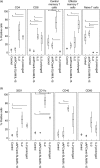Ex vivo expanded telomerase-specific T cells are effective in an orthotopic mouse model for pancreatic adenocarcinoma
- PMID: 19737239
- PMCID: PMC2759067
- DOI: 10.1111/j.1365-2249.2009.03935.x
Ex vivo expanded telomerase-specific T cells are effective in an orthotopic mouse model for pancreatic adenocarcinoma
Abstract
Telomerase activity is over-expressed in nearly all pancreatic carcinomas, but not in chronic pancreatitis. Here, we investigated various protocols for expansion of telomerase-specific T cells for adoptive cell transfer and their use in a syngeneic pancreatic carcinoma mouse model. Telomerase-specific T cells were generated by stimulation of splenocytes from peptide-immunized donor mice with either interleukin (IL)-2, IL-15, artificial antigen-presenting cells, anti-signalling lymphocyte activation molecule (SLAM) microbeads or allogeneic dendritic cells in combination with a limited dilution assay. T cells were tested for antigen specificity in vitro and for anti-tumour activity in syngeneic mice with orthotopically implanted tumours pretreated with cyclophosphamide. The immune cells from recipients were immunophenotyped. During a period of 2 weeks, the expansion approach using IL-2 was very successful in generating a high number of telomerase-specific CD8(+) T cells without losing their function after adoptive cell transfer. Significantly slower tumour growth rate and less metastasis were observed after adoptively transferring telomerase specific CD8(+) T cells, expanded using IL-2. Further investigations showed that anti-tumour efficacy was associated with a significant shift from naive CD8(+) T cells to CD8(+) central memory T cells, as well as recruitment of a high number of dendritic cells. Remarkable amounts of telomerase-specific T cells were detectable in the tumour. Generation of telomerase-specific T cells is feasible, whereat IL-2-based protocols seemed to be most effective and efficient. Antigen-specific T cells showed significant cytotoxic activity in a syngeneic, orthotopic mouse model, whereas central memory T cells but not effector memory T cells appear to be of high importance.
Figures






Similar articles
-
Transfection with CD40L induces tumour suppression by dendritic cell activation in an orthotopic mouse model of pancreatic adenocarcinoma.Gut. 2008 Mar;57(3):344-51. doi: 10.1136/gut.2007.130252. Epub 2007 Aug 3. Gut. 2008. PMID: 17675324
-
Telomerase-specific T-cells kill pancreatic tumor cells in vitro and in vivo.Cancer. 2006 Feb 15;106(4):759-64. doi: 10.1002/cncr.21655. Cancer. 2006. PMID: 16369992
-
Expansion of Tumor-reactive T Cells From Patients With Pancreatic Cancer.J Immunother. 2016 Feb-Mar;39(2):81-9. doi: 10.1097/CJI.0000000000000111. J Immunother. 2016. PMID: 26849077
-
In vitro methods for generating CD8+ T-cell clones for immunotherapy from the naïve repertoire.J Immunol Methods. 2006 Mar 20;310(1-2):40-52. doi: 10.1016/j.jim.2005.11.023. Epub 2006 Jan 26. J Immunol Methods. 2006. PMID: 16469329
-
Induction/engineering, detection, selection, and expansion of clinical-grade human antigen-specific CD8 cytotoxic T cell clones for adoptive immunotherapy.J Biomed Biotechnol. 2010;2010:705215. doi: 10.1155/2010/705215. Epub 2010 Mar 10. J Biomed Biotechnol. 2010. PMID: 20224660 Free PMC article. Review.
Cited by
-
BPTF Depletion Enhances T-cell-Mediated Antitumor Immunity.Cancer Res. 2016 Nov 1;76(21):6183-6192. doi: 10.1158/0008-5472.CAN-15-3125. Epub 2016 Sep 20. Cancer Res. 2016. PMID: 27651309 Free PMC article.
-
Emerging trends in the immunotherapy of pancreatic cancer.Cancer Lett. 2018 Mar 28;417:35-46. doi: 10.1016/j.canlet.2017.12.012. Epub 2017 Dec 12. Cancer Lett. 2018. PMID: 29242097 Free PMC article. Review.
-
The dark side of immunotherapy: pancreatic cancer.Cancer Drug Resist. 2020 May 11;3(3):491-520. doi: 10.20517/cdr.2020.13. eCollection 2020. Cancer Drug Resist. 2020. PMID: 35582441 Free PMC article. Review.
References
-
- Raraty MG, Magee CJ, Ghaneh P, Neoptolemos JP. New techniques and agents in the adjuvant therapy of pancreatic cancer. Acta Oncol. 2002;41:582–95. - PubMed
-
- Picozzi VJ, Kozarek RA, Traverso LW. Interferon-based adjuvant chemoradiation therapy after pancreaticoduodenectomy for pancreatic adenocarcinoma. Am J Surg. 2003;185:476–80. - PubMed
-
- Jaffee EM, Hruban RH, Biedrzycki B, et al. Novel allogeneic granulocyte–macrophage colony-stimulating factor-secreting tumor vaccine for pancreatic cancer: a phase I trial of safety and immune activation. J Clin Oncol. 2001;19:145–56. - PubMed
Publication types
MeSH terms
Substances
LinkOut - more resources
Full Text Sources
Medical
Research Materials

